Preamble
For your convenience I have listed below other posts on Australian aboriginal textiles and artwork.
Untitled Artworks (Exhibition - ArtCloth: Engaging New Visions) Tjariya (Nungalka) Stanley and Tjunkaya Tapaya, Ernabella Arts (Australia)
ArtCloth from the Tiwi Islands
Aboriginal Batik From Central Australia
ArtCloth from Utopia
Aboriginal Art Appropriated by Non-Aboriginal Artists
ArtCloth from the Women of Ernabella
ArtCloth From Kaltjiti (Fregon)
Australian Aboriginal Silk Paintings
Contemporary Aboriginal Prints
Batiks from Kintore
Batiks From Warlpiri (Yuendumu)
Aboriginal Batiks From Northern Queensland
Artworks From Remote Aboriginal Communities
Urban Aboriginal ArtCloths
Western Australian Aboriginal Fabric Lengths
Northern Editions - Aboriginal Prints
Aboriginal Bark Paintings
Contemporary Aboriginal Posters (1984) - (1993)
The Art of Arthur Pambegan Jr
Aboriginal Art - Colour Power
Aboriginal Art - Part I
Aboriginal Art - Part II
The Art of Ngarra
The Paintings of Patrick Tjungurrayi
Warlimpirrnga Tjapaltjarri
Australian Aboriginal Rock Art - Part I
Australian Aboriginal Rock Art - Part II
Warlimpirrnga Tjapaltjarri[1]
Warning: This post might contain images of aboriginal persons who are deceased. If you are of an aboriginal heritage you may not wish to view or read this post.
Pintupi artist Warlimpirrnga Tjapaltjarri comes from Kiwirrkura. It is located 700 km west of Alice Springs (Australia), just over the border of Western Australia. The area was traditionally the home to the Pintupi people who identify themselves as being "people from the west" (of Papunya). From the 1940s, they were relocated by the government to the communities of Papunya and Haasts Bluff. By 1983 the aboriginal people were free to relocate to their "country" and so be near the numerous culturally significant sites such as Wilkinkarra (Lake Mackay), Ngami, wirrul and Marrapinti.
Kiwirrkura is one of the most remote of all Aboriginal communities. In early 2001 the entire community consisted of about 170 people. It is a great place to hunt, and many local people enjoy the luxury of their fertile hunting grounds which sit only a short distance from their community.
Pintupi artist Warlimpirrnga Tjapaltjarri is a man of unique understanding in his community. He was one of the "Pintupi Nine" (also erroneously referred to as the "lost tribe") - the last of nine indigeneous Australians living a nomadic and completely traditional existence who walked out of the desert in 1984. The story made headlines all over the world.
The day the Pintupi Nine entered the modern world by Alana Mahony, Kiwirrkurra (published on 23 December 2014).
In 1984 a group of Australian Aboriginal people living a traditional nomadic life were encountered in the heart of the Gibson desert in Western Australia. They had been unaware of the arrival of Europeans on the Australian continent, let alone cars or even clothes.
Just four years later Warlimpirrnga Tjapaltjarri presented a solo show of his paintings at the Gallery Gabrielle Pizzi in Melbourne (Australia).
Australian Art Gallery - Gallery Gabrielle Pizzi (Melbourne).
Initially hesitant as an artist, Warlimpirrnga Tjapaltjarri was encourgaged by the former manager of Papuunya Tula Artists, Daphne Williams and on exhibiting his 24 works, all were purchased by the Melbourne-based dealers Ron and Nellie Castan on behalf of the National Gallery of Victoria. The early success boosted the young artist's confidence and he set about painting in earnest. He quickly became a prominent aboriginal artist and exhibited in main venues throughout the Western world.
He was influenced by other great Papunya artists including Kanya Tjapangati and the visual minimalism emerging from some of the other painters of the time, namely, George Tjungurrayi, Mick Namarari, Ronnie Tjampitjinpa and Turkey Tolson. His paintings became more minimal and, at the same time, more sophisticated as he established himself as one of the most important artists of his generation.
Untitled (2009)
Materials: Acrylic on Belgian linen.
It’s not a customary feeling for Mr. Tjapaltjarri (his full name is pronounced war-lehm-peer-ing-ah jah-pal-jah-ree), who was the eldest male in his family in the desert and, as a healer and keeper of ancestral stories at the heart of the Pintupi people, is still a commanding presence in Kiwirrkurra, the community where he lives in the Gibson Desert. The paintings that have made him a sought-after figure in the Desert Painting movement, which arose in the 1970s and sowed international interest in Aboriginal art, are in one sense transcriptions of the stories. They seem abstract, made from thousands of dots — a signature of much Desert Painting. The dots form tight parallel lines that, when viewed close up, oscillate like those of a Bridget Riley Op Art painting, except more so, a visual equivalent of standing near a speaker that drowns out all the sound around it.
An untitled painting by Warlimpirrnga Tjapaltjarri in his show at Salon 94. He began painting on canvas in the 1980s after his family was “discovered” in the wild.
Credit: Karsten Moran,The New York Times.
Tingari Dreaming by Warlimpirrnga Tjapaltjarri from Kiwirrkurra, Western Desert.
Materials: Acrylic on Belgian Linen.
Untitled (2009)
Materials: Acrylic on Belgian Linen.
Untitled (2008)
Medium: Acrylic on Belgian linen.
Untitled
Medium: Synthetic polymer paint on linen.
Signature & Dated: Not signed nor dated.
Credit: Gift of the Art Gallery Society of New South Wales (1995).
Courtesy: The Art Gallery of NSW.
Reference:
[1] https://aboriginalartgalleries.com.au/artist/595-warlimpirrnga-tjapaltjarri
For your convenience I have listed below other posts on Australian aboriginal textiles and artwork.
Untitled Artworks (Exhibition - ArtCloth: Engaging New Visions) Tjariya (Nungalka) Stanley and Tjunkaya Tapaya, Ernabella Arts (Australia)
ArtCloth from the Tiwi Islands
Aboriginal Batik From Central Australia
ArtCloth from Utopia
Aboriginal Art Appropriated by Non-Aboriginal Artists
ArtCloth from the Women of Ernabella
ArtCloth From Kaltjiti (Fregon)
Australian Aboriginal Silk Paintings
Contemporary Aboriginal Prints
Batiks from Kintore
Batiks From Warlpiri (Yuendumu)
Aboriginal Batiks From Northern Queensland
Artworks From Remote Aboriginal Communities
Urban Aboriginal ArtCloths
Western Australian Aboriginal Fabric Lengths
Northern Editions - Aboriginal Prints
Aboriginal Bark Paintings
Contemporary Aboriginal Posters (1984) - (1993)
The Art of Arthur Pambegan Jr
Aboriginal Art - Colour Power
Aboriginal Art - Part I
Aboriginal Art - Part II
The Art of Ngarra
The Paintings of Patrick Tjungurrayi
Warlimpirrnga Tjapaltjarri
Australian Aboriginal Rock Art - Part I
Australian Aboriginal Rock Art - Part II
Warlimpirrnga Tjapaltjarri[1]
Warning: This post might contain images of aboriginal persons who are deceased. If you are of an aboriginal heritage you may not wish to view or read this post.
Pintupi artist Warlimpirrnga Tjapaltjarri comes from Kiwirrkura. It is located 700 km west of Alice Springs (Australia), just over the border of Western Australia. The area was traditionally the home to the Pintupi people who identify themselves as being "people from the west" (of Papunya). From the 1940s, they were relocated by the government to the communities of Papunya and Haasts Bluff. By 1983 the aboriginal people were free to relocate to their "country" and so be near the numerous culturally significant sites such as Wilkinkarra (Lake Mackay), Ngami, wirrul and Marrapinti.
Kiwirrkura is one of the most remote of all Aboriginal communities. In early 2001 the entire community consisted of about 170 people. It is a great place to hunt, and many local people enjoy the luxury of their fertile hunting grounds which sit only a short distance from their community.
Pintupi artist Warlimpirrnga Tjapaltjarri is a man of unique understanding in his community. He was one of the "Pintupi Nine" (also erroneously referred to as the "lost tribe") - the last of nine indigeneous Australians living a nomadic and completely traditional existence who walked out of the desert in 1984. The story made headlines all over the world.
The day the Pintupi Nine entered the modern world by Alana Mahony, Kiwirrkurra (published on 23 December 2014).
In 1984 a group of Australian Aboriginal people living a traditional nomadic life were encountered in the heart of the Gibson desert in Western Australia. They had been unaware of the arrival of Europeans on the Australian continent, let alone cars or even clothes.
Just four years later Warlimpirrnga Tjapaltjarri presented a solo show of his paintings at the Gallery Gabrielle Pizzi in Melbourne (Australia).
Australian Art Gallery - Gallery Gabrielle Pizzi (Melbourne).
Initially hesitant as an artist, Warlimpirrnga Tjapaltjarri was encourgaged by the former manager of Papuunya Tula Artists, Daphne Williams and on exhibiting his 24 works, all were purchased by the Melbourne-based dealers Ron and Nellie Castan on behalf of the National Gallery of Victoria. The early success boosted the young artist's confidence and he set about painting in earnest. He quickly became a prominent aboriginal artist and exhibited in main venues throughout the Western world.
He was influenced by other great Papunya artists including Kanya Tjapangati and the visual minimalism emerging from some of the other painters of the time, namely, George Tjungurrayi, Mick Namarari, Ronnie Tjampitjinpa and Turkey Tolson. His paintings became more minimal and, at the same time, more sophisticated as he established himself as one of the most important artists of his generation.
Untitled (2009)
Materials: Acrylic on Belgian linen.
It’s not a customary feeling for Mr. Tjapaltjarri (his full name is pronounced war-lehm-peer-ing-ah jah-pal-jah-ree), who was the eldest male in his family in the desert and, as a healer and keeper of ancestral stories at the heart of the Pintupi people, is still a commanding presence in Kiwirrkurra, the community where he lives in the Gibson Desert. The paintings that have made him a sought-after figure in the Desert Painting movement, which arose in the 1970s and sowed international interest in Aboriginal art, are in one sense transcriptions of the stories. They seem abstract, made from thousands of dots — a signature of much Desert Painting. The dots form tight parallel lines that, when viewed close up, oscillate like those of a Bridget Riley Op Art painting, except more so, a visual equivalent of standing near a speaker that drowns out all the sound around it.
An untitled painting by Warlimpirrnga Tjapaltjarri in his show at Salon 94. He began painting on canvas in the 1980s after his family was “discovered” in the wild.
Credit: Karsten Moran,The New York Times.
Tingari Dreaming by Warlimpirrnga Tjapaltjarri from Kiwirrkurra, Western Desert.
Materials: Acrylic on Belgian Linen.
Untitled (2009)
Materials: Acrylic on Belgian Linen.
Untitled (2008)
Medium: Acrylic on Belgian linen.
Untitled
Medium: Synthetic polymer paint on linen.
Signature & Dated: Not signed nor dated.
Credit: Gift of the Art Gallery Society of New South Wales (1995).
Courtesy: The Art Gallery of NSW.
Reference:
[1] https://aboriginalartgalleries.com.au/artist/595-warlimpirrnga-tjapaltjarri


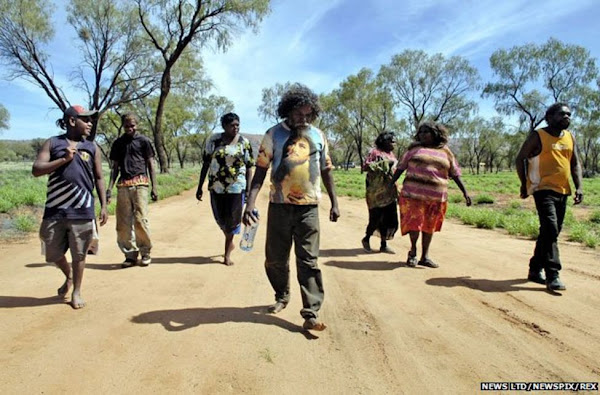
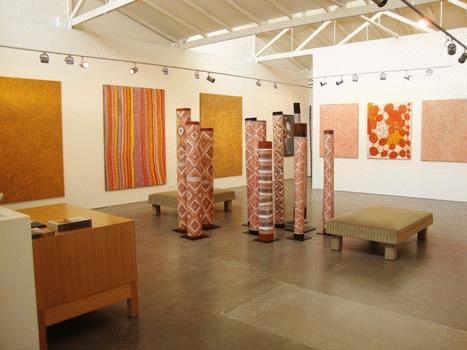

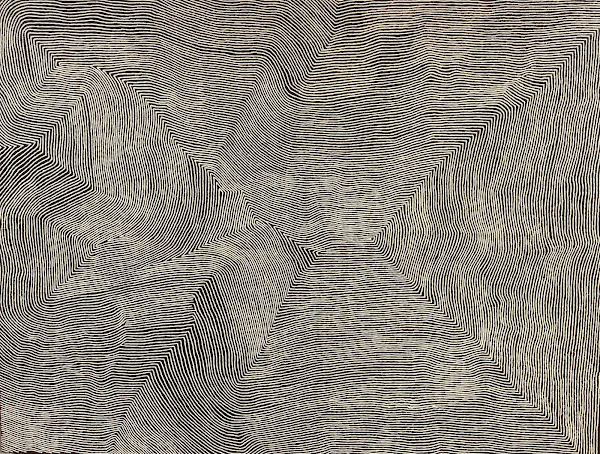


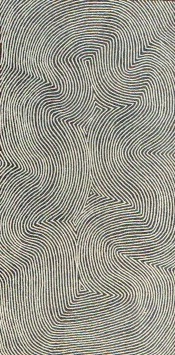

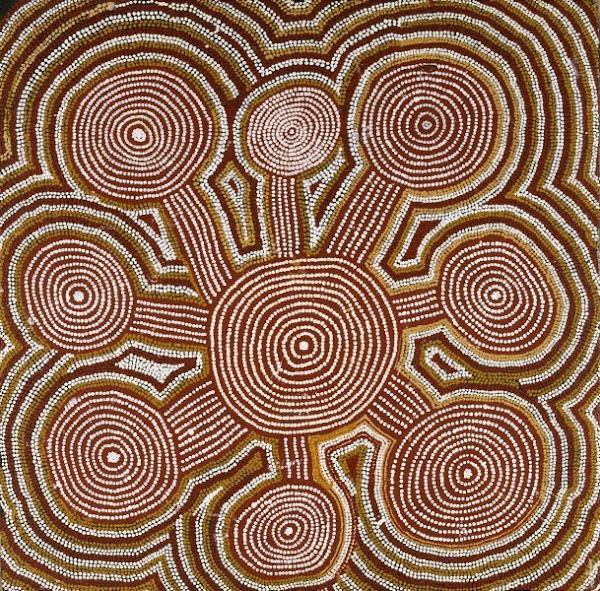
No comments:
Post a Comment